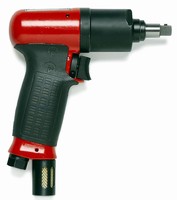CP's Pneumatic PT Series Impulse Tools Now Better for Operator and Productivity

Need a pneumatic assembly tool that minimizes noise, vibration and operator fatigue while consistently delivering the desired torque fast?
Look no further than CP for the finest in pneumatic impulse tool innovation. Eighteen improved PT series impulse tools are available in seven non-shutoff and 11 shutoff models.
Impulse tools have these advantages over impact wrenches and ratchet screwdrivers:
o Low reaction force, vibration and noise for operator comfort
o High torque output to tool weight ratio
o High speed for shorter process time, improved productivity
o Wider torque range, greater accuracy
o Enhanced process consistency among operators, minimized rework and boosted productivity
o Extended tool endurance between servicing intervals
o Encapsulated hydraulic pulse mechanism eliminates need to lubricate the motor
Shutoff and Non-shutoff Impulse Models
The seven non shut-off PT impulse tool models deliver from 20 to 240 Nm (15 to 177 ft-lb) of torque at speeds up to 10,000 rpm. Noise levels: 74 dB(A) for the 20-31 Nm/10,000 rpm PT031 model; 81 dB(A) for the 160-240 Nm/2,800 rpm PT240 model. Weight for lowest to highest torque-rated tool models runs 0.7-3.3 kg/1.5-7.3 lb.
The 11 shut-off PT impulse tool models deliver from 5 to 450 Nm (4 to 332 ft-lb) of torque at speeds up to 5,500 rpm. Noise levels: 74 dB(A) for the 5-10 Nm/5,500 rpm PT010 model; 85 dB(A) for the 225-450 Nm/3,000 rpm PT450 model. Weight for lowest to highest torque-rated tool models runs 0.95-4.3 kg/2.1-9.5 lb.
Non-shutoff range
MODEL PART OUTPUT FREE TORQUE WEIGHT AIR AIR HOSE INT. Sound
NUMBER SPEED RANGE FLOW INLET Ø level
in. rpm Nm ft.lb kg lb l/s cfm in. mm in. dB(A)
PT031-L10000-I10S 2051474664 3/8 10000 20-31 15-23 0,7 1,5 8 17 1/4 8 5/16 74
PT031-T9000-I10S 2051474674 3/8 9000 20-31 15-23 0,8 1,8 8 17 1/4 8 5/16 75
PT052-T7000-I10S 2051474684 3/8 7000 30-52 22-38 1,0 2,0 9 19 1/4 10 3/8 80
PT070-T6000-I13S 2051474694 1/2 6000 50-70 37-52 1,3 2,9 11 23 1/4 10 3/8 78
PT110-T4500-I13S 2051474704 1/2 4500 65-110 48-81 1,6 3,5 12 25 1/4 10 3/8 79
PT160-T3500-I13S 2051474714 1/2 3500 110-160 81-118 2,4 5,3 14 30 3/8 13 1/2 79
PT240-T2800-I19S 2051474724 3/4 2800 160-240 118-177 3,3 7,3 15 32 3/8 13 1/2 81
Shutoff range
MODEL PART OUTPUT FREE TORQUE WEIGHT AIR AIR HOSE INT. Sound
NUMBER SPEED RANGE FLOW INLET Ø level
in. rpm Nm ft.lb kg lb l/s cfm mm in. dB(A)
PT010-T5500-S4Q 2051462274 Hex 1/4 5500 5-10 4-7 0,95 2,1 6 13 1/4 8 5/16 74
PT010-L5000-S4Q 2051462254 Hex 1/4 5000 5-10 4-7 0,9 1,9 6 13 1/4 8 5/16 74
PT014-T6000-S4Q 2051462284 Hex 1/4 6000 8-14 6-10 1,0 2,2 6 13 1/4 8 5/16 74
PT014-L6000-S4Q 2051462264 Hex 1/4 6000 8-14 6-10 0,9 2,0 6 13 1/4 8 5/16 74
PT025-T4500-S10S 2051474624 3/8 4500 13-25 10-18 1,3 2,9 7 15 1/4 8 5/16 77
PT025-L4500-S10S 2051474634 3/8 4500 13-25 10-18 1,2 2,5 7 15 1/4 8 5/16 78
PT040-T6000-S10S 2051462294 3/8 6000 22-40 16-29 1,4 3,0 8 17 1/4 8 5/16 77
PT070-T4000-S13S 2051462304 1/2 4000 32-70 24-51 1,8 4,0 10 21 1/4 10 3/8 81
PT125-T3500-S13S 2051462314 1/2 3500 62-125 46-92 2,4 5,3 12 25 1/4 10 3/8 81
PT250-T2200-S19S 2051474644 3/4 4000 125-250 92-185 3,3 7,2 20 42 3/8 13 1/2 82
PT450-T1900-S19S 2051474654 3/4 3000 225-450 166-332 4,3 9,5 22 46 3/8 13 1/2 85
Comparisons to Impact Tools and Ratchet Wrenches
An impulse tool produces a pulse for a very short period of time to give a smooth rundown and very little torque reaction. An impact wrench gives a rapid succession of sudden mechanical blows to reach torque to which the operator feels a reaction. A ratchet wrench applies torque only in one direction by means of a toothed wheel with a catch or pawl. Achieving the proper torque is dependent upon operator "feel" and is less precise during tightening repetitions.
How the CP Impulse Tools Work
A CP impulse tool has a twin chamber motor that provides higher torques at low speeds and greater torque during pulsing. A non shut-off impulse tool motor has a cam and two or three blades, while the shut-off tool motor contains a cam and rollers.
In the CP non-shutoff models, a motor drives the twin blades of the PT031/052 and triple blades of the PT070/240. An oil flow valve allows oil to fill the internal chamber; an adjustment screw sets the torque level. The motor spindle is joined to the output drive of the tool. When the spindle stops, the cam and housing continue to rotate. When sealing positions are reached, increased oil pressure creates impulses on both blades. The oil then passes through the valve, and the cycle begins again.
The CP shutoff models contain a patented anvil with pistons and rollers that move in a radius while a camshaft driven by a motor pushes them in and out. The pistons and rollers transfer the torque directly to the spindle. The few moving parts are immersed in oil, ensuring a smooth operation that also contributes to tool durability.
When the shutoff impulse tools are running freely, air passes through the pneumatic valve and the inertia mass rotates with the pulse unit. During shutoff, the pulse unit stops and the air valve closes. Low air pressure increases the final torque value, and the tool impulses more before shutoff.
Reverse torque is always the maximum value. All models have an air cooling exhaust for the pulse unit. CP's patented cam design prevents high spring wear found in competitors' tools.
If the ambient operating temperature is very low, the tool should be cycled several times to build up the oil temperature. The tool is less susceptible, however, to changes in oil level.
Each PT series impulse tool is equipped includes a patented adjustable valve with an advanced silencer. This valve regulates the air flow during rundown to improve performance on hard joints at low torque levels.
During rundowns, the speed decreases due to back pressure created by the adjustable valve. The slow rundown reduces energy, thereby improving accuracy. During the pulse phase, the tool requires less air, so tightening is not compromised by the adjustable valve.
How and Where to Use Impulse Tools
Impulse tools can be used in a variety of ways for a variety of applications.
Use impulse tools to:
o Eliminate operator influence on the fastening cycle and improve repeatability
o Reduce operating time
o Lessen air consumption
o Reduce operator exposure to vibration, noise and fatigue
Proper Usage - An Impulse Tool Should:
o Be run until the shutoff occurs
o Always pulse 3 to 5 times to provide consistency
o Be upgraded to the next larger capacity tool if the tightening cycle lasts 3 to 5 seconds
o Always have a higher maximum torque than the torque required on soft joints
o Be well maintained: worn sockets and extensions should be replaced to prevent vibration, loss in torque output, accuracy and damage to the output drive
o Be verified for torque accuracy by comparing measurements with a static torque wrench
Markets
o Land transportation vehicles and motor vehicle components
o Appliances
o General industrial applications
Applications
o Long bolts for adjustable feet on large refrigerators, ranges, washing machines, etc.
o Rotating parts, such as fans in convection and microwave ovens
o Soft joints such as clamp rings on washing machine drums, alternator and electric motor assemblies brake calipers, and any assembly using gaskets and/or seals
Accessories include various configurations of impact bits.
Ergonomics
Injuries due to tool reaction and weight can be costly. The following chart shows the number of days a worker may be off the job due to an injury:
Injury to: Average absence in days:
Shoulder 220
Elbow 160
Hand/wrist 120
Knee 59
Ankle 100
Due to their smooth operation, Impulse tools may contribute to reductions in user strain and injury.
For Additional Information contact:
Linda Ashley
Communications - Industrial/Land Transportation
CP North America Customer Center
Chicago Pneumatic Tool Company
Phone 248-348-6365
Fax 866-880-5810
Email linda.ashley@cp.com



